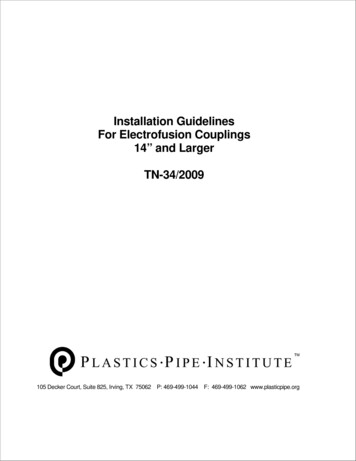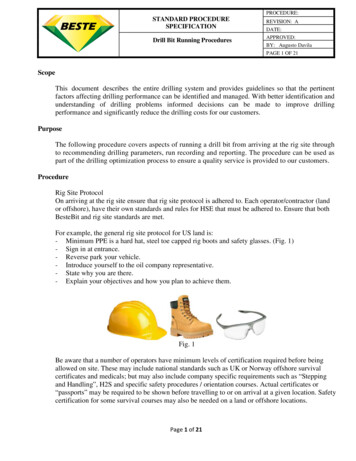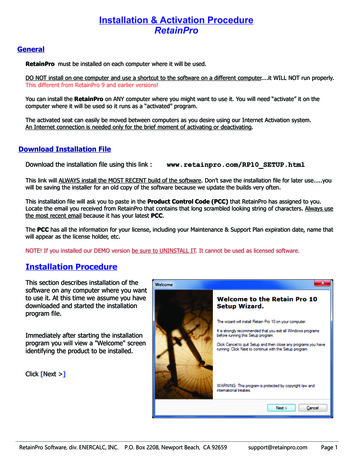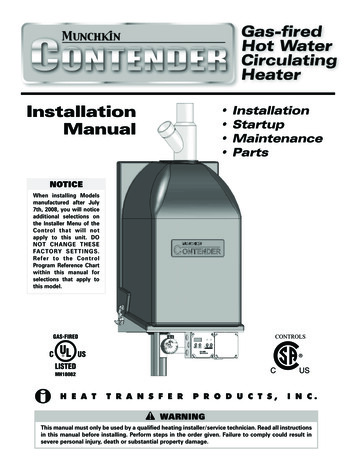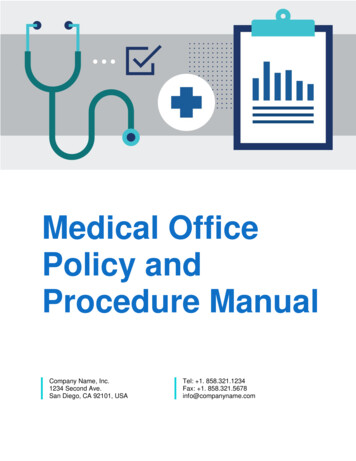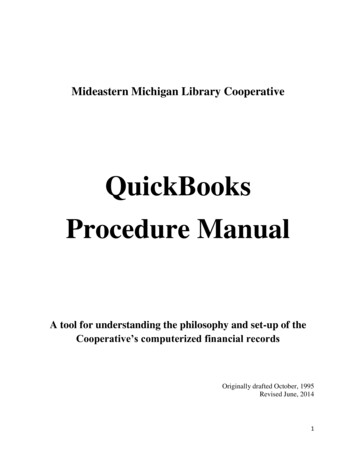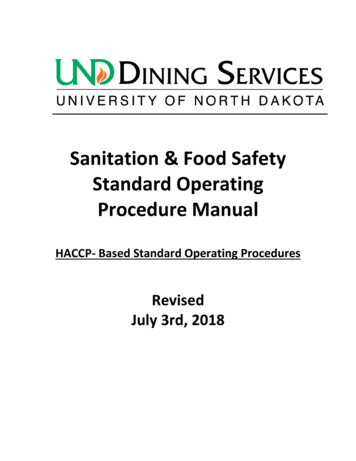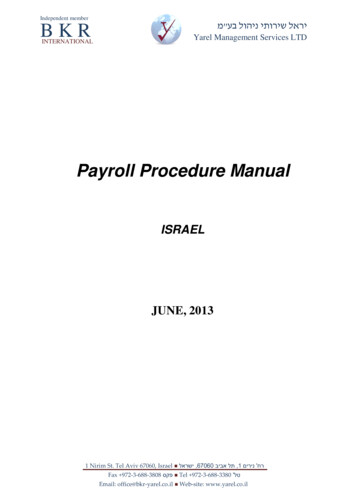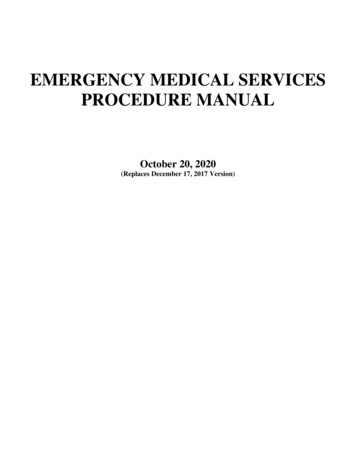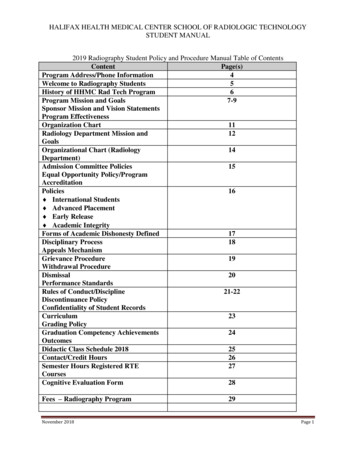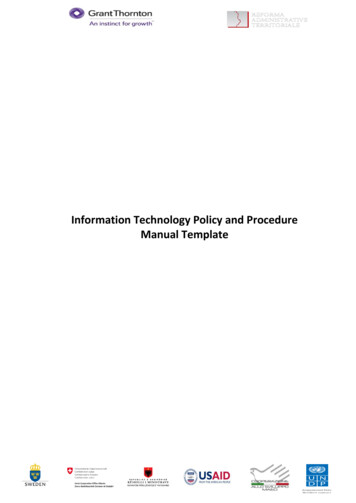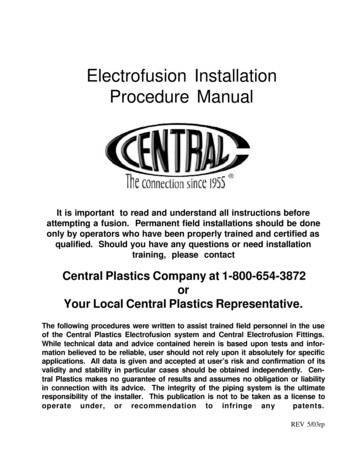
Transcription
Electrofusion InstallationProcedure ManualIt is important to read and understand all instructions beforeattempting a fusion. Permanent field installations should be doneonly by operators who have been properly trained and certified asqualified. Should you have any questions or need installationtraining, please contactCentral Plastics Company at 1-800-654-3872orYour Local Central Plastics Representative.The following procedures were written to assist trained field personnel in the useof the Central Plastics Electrofusion system and Central Electrofusion Fittings.While technical data and advice contained herein is based upon tests and information believed to be reliable, user should not rely upon it absolutely for specificapplications. All data is given and accepted at user’s risk and confirmation of itsvalidity and stability in particular cases should be obtained independently. Central Plastics makes no guarantee of results and assumes no obligation or liabilityin connection with its advice. The integrity of the piping system is the ultimateresponsibility of the installer. This publication is not to be taken as a license tooperate under, or recommendation to infringe anypatents.REV 5/03rp
Table of ContentsBefore You Start1Electrofusion Power Requirements2Proper Pipe Preparation for Electrofusion3Acceptable Markers for Electrofusion4Pipe Re-Rounding Statement5Fitting Restraint Statement7Barcode Scanning Instructions8Electrofusion Cooling Statement9Re-Fusion of Electrofusion Fittings Recommendation10Hydrostatic Testing of Electrofusion Fittings11Electrofusion Joining Proceduresfor Couplings12Electrofusion Joining Proceduresfor Sidewall/Saddle Fittings with Under-Clamp15Electrofusion Joining Proceduresfor Sidewall/Saddle Fittings with Top-Load Clamp17Electrofusion Joining Proceduresfor Branch Saddle Fittings with T-Clamp18Electrofusion Joining Proceduresfor Flex Restraints with Ratchet Strap Clamp22Examples of Incorrect Electrofusion Joints24Destructive Testing Procedures for ElectrofusionFitting Qualification27
Before You StartThe following is an installation guide for the purpose of assisting the installer in adequatelypreparing an electrofusion fitting and pipe for fusion. This document is a guide only, andshould not be used in place of training by an authorized electrofusion instructor. Therecommended joining procedures for the Central Electrofusion System detailed in thismanual have been qualified in accordance with D.O.T. 192.283Central Plastics Company strongly recommends that electrofusion fittings be installed onlyby persons that have received training from an authorized instructor, that have a strongworking knowledge of polyethylene and heat fusion, and have qualified electrofusion jointsthrough destructive testing. Persons responsible for the joining of polyethylene pipe byfusion methods must qualify according to the requirement of the Title 49 Code of FederalRegulations, Section 192.285.The installer of the electrofusion fittings for pressure applications should have knowledge ofthe intended application and is responsible for any fitting that is installed into a system thatis not suitable for electrofusion fittings. Central Plastics electrofusion fittings are designedfor use on pipe conforming to ASTM standard D2513 & F714 dimensions and with fittingsconforming to D3261. All pipe to which these fittings are installed should meet the dimensional requirements of these standards.Whether the installer is in a controlled environment or in the field making electrofusionfitting joints, Central Plastics recommends that you have the following equipment:1. PIPE PREPARATION EQUIPMENTPipe Cutting ToolsPipe Scraping ToolsPipe Cleaning MaterialPipe re-rounding tools (on larger pipe sizes)2. PIPE RESTRAINT EQUIPMENT3. FUSION EQUIPMENTFusion Processor with correct leads and/or tipsAdequate power supplyIMPORTANT NOTE:Pipe preparation and contamination are very important considerations in theelectrofusion process. Careful attention must be given to proper scrapingand cleaning procedures.Page 1
ELECTROFUSION POWER REQUIREMENTSGENERATORSFor the installation of electrofusion fittings in field applications, it will be necessary to have a reliable source ofAC power for the Electrofusion Processor to work properly in supplying the fitting with the right amount ofenergy. Generators used as an AC power source should conform to the following;····Be well maintained and subjected to a periodic maintenance schedule;Provide an output voltage in the range that meets the specifications of the applicableprocessor model;Operate within a frequency range of 45 Hertz minimum to 75 Hertz maximum;A minimum wattage capacity of;MinimumKVA5.0 KVA3.5 KVA2.0 KVAFitting RangeWill fuse all Central Plastics fittings including 24" DIPS / 630 mm couplingsWill fuse Couplings up to 8"/ 225 mm and all Tapping Tees, High Volume Tapping Tees,Branch Saddles and ReducersWill fuse Couplings up to 1 1/4", and all Tapping Tees, High Volume Tapping Tees,Branch Saddles and Reducers·A matching outlet is needed to mate with the plug equipped with the unit by Central:120V models — 30 Amp, 125 Volt, NEMA L5, twist-lock;INVERTERSInverters can be used as an acceptable AC power source but with the continuing changes in inverter technologies,earlier processor models may not be compatible to the quasi-sine waveform produced by some inverters. Centralrecommends performing compatibility tests using the lightest and heaviest anticipated loads before approving an invertersystem. Feel free to contact Central to discuss issues regarding the use of inverters.EXTENSION CORDSDue to the amperage draw of electrofusion fittings, use of extension cords are not encouraged but in the event it becomes necessary to use one the following lengths and wire gages are recommended:Cord Length25 ft.50 ft.Wire Gage#10/3 wire (6 mm2)# 8/3 wire (10 mm2)NO EXTENTION CORDS SHOULD BE USED ON 14” IPS & LARGER COUPLINGSPIGTAILS - (30 Amp Twist Lock to 15 Amp Standard Plug Adapter)The use of pigtails for in field applications of electrofusion fittings is not recommended except on fitting sizes 2" andsmaller.POWERING UPPrior to beginning the electrofusion sequence, it is important that you ensure the following:··The generator has enough fuel to complete the electrofusion cycleThe throttle is opened all the way (in anticipation of power draw)IMPORTANT NOTE FOR COLD WEATHER INSTALLATIONS:Cold weather affects both fittings and equipment. Electrofusion fittings require more energy at the beginning of the fusioncycle, this requirement is increased in cold weather situations. Make sure that your generator is in good mechanicalcondition and that it meets the minimum wattage output.Page 2
Proper Pipe Preparation for Electrofusion FittingsFor a pipe surface to be properly prepared for electrofusion the outer layer or “skin” ofthe pipe should be removed to expose a clean, virgin pipe material. This can beachieved by using one of several types of approved scraping tools. “Approved”scraping tools can vary widely between electrofusion manufacturers and they may notnecessarily be a tool that is manufactured by the fitting manufacturer. A few examplesof scraping tools that Central Plastics classifies as “approved” are; a rasp type tool(Stanley Surform Model 21-296 or equivalent), a metal blade paint scraper, or toolsmanufactured specifically for electrofusion scraping. “Approved” simply indicates thatthe tool has been qualified by the manufacturer and has been found to perform in asatisfactory manner under the joining conditions established by the manufacturer.Wood rasps or metal files are not considered acceptable.It is very important to note that abrasive materials, such as sandpaper or emory cloth,should never be used in place of a scraping tool. Abrasive materials have been provento be ineffective in the removal of sufficient amounts of surface material needed toachieve an electrofusion bond and in fact, they have actually been shown to impedethe electrofusion process. This is due to the grit or grit like residue they imbed into thepipe area being scraped, which in turn acts as a barrier between the pipe and fitting.The electrofusion process significantly differs from conventional heat fusion. In theelectrofusion process there is very little material movement or melt displacement (i.e.melt beads).For this reason, any contaminant that is present on the surface of thepipe will remain sandwiched between the pipe and fitting interface and will ultimatelyprevent the two materials from joining. It is also recommended that the “Metal File”type of rasp not be used as a pipe scraper; as the pipe material is removed with thistype of tool, tends to ball up and roll around on the pipe surface instead of beingcleanly removed and directed away.Central Plastics Company recommends that a minimum of .007” to .010” of the pipe’ssurface material be removed during the scraping process in order to expose a cleanvirgin material. This is approximately the thickness of two sheets of paper. It is important that the pipe surface be clean and free from any type of contaminants that may bespread before scraping begins. Should the pipe surface be contaminated with dirt,mud or drilling fluids before scraping, plain water may be used to remove the surfacelevel of these contaminates. It should be noted however, that water cannot be used toclean the pipe surfaces once the virgin material has been exposed. In those instances a minimum 70% isopropyl alcohol concentration, with no additional additives, has been found to be highly effective in removing these type of contaminatesand is recommended by Central Plastics as a cleaning agent that can be used beforeand after scraping. For applications where a fitting will be moved around on the pipe,such as a repair application where a coupling will be pushed completely over one endof the pipe, it is recommended that pipe be scraped for the entire length of the coupling to prevent a clean fitting from being contaminated by unscraped pipe.Page 3
MarkersMarks can be made on the outer surface of the pipe as a visual aid to help indicatethe required scraper coverage. Marks made on the pipe should not be made with a“grease pencil” or other type of petroleum based marker that will leave a contaminatebehind. Central Plastics Company’s only requirement for markers used on PEpipe during electrofusion preparation is that the marker be non-petroleumbased. Grease pencils are generally petroleum based and therefore should not beused on PE pipe prior to electrofusion joining.We have found many different types and brands of markers to be acceptable andrecommend that any permanent marker of a color that will show on the pipe materialcan be used. The permanent type markers, such as the, “Sharpie”, “Marks-A-Lot”and “Magic Marker” by Avery are adequate for marking yellow or light colored pipe.Fast drying paint pens, such as those manufactured by PENTEL and Faber Castell,also work well and are available in colors that will show well on black pipe; it issometimes necessary to allow for drying when using paint type pens. We have alsofound that a wax based “China Marker”, although not permanent, works well for marking black pipe. We have found no advantage of one type of marker, permanent orpaint, over the other.Page 4
Re-RoundingThe non-brittle and flexible material characteristic of polyethylene makes it ideal formany pressure and non-pressure applications. But this material characteristic alonebrings with it an important consideration that must be taken into account when usingpolyethylene pipe.“Care must be taken to ensure that the polyethylene pipe is not out-of-roundbefore attempting the electrofusion process.”HOW DOES POLYETHYLENE PIPE BECOME OUT- OF- ROUND?1. FROM THE MANUFACTURER: It is important for the installer to confirm that thepolyethylene pipe meets all dimensional requirements of ASTM 2513 and F714 andthat the pipe does not exceed 5% ovality. If ovality is greater than 5% (see chartbelow), the installer must take steps to re-round the pipe.PIPE SIZE45IPS PE SIZE4681012141618202430364248DIPS 819.58821.69725.91632.11438.47244.70051.0292. IN THE WAREHOUSE: Polyethylene pipe that is warehoused for a period of time orstacked on top of each other can experience ovality related issues (this is morepronounced with large diameter pipe).3. OVER TIME: Large Diameter Polyethylene pipe will tend to relax a little duringstorage due to a combination of its weight and its natural flexibility.4. DURING INSTALLATION: Mechanical forces experienced during some trenchlessinstallation techniques such as Pipe Bursting or Directional Drilling can temporarilyleave the Polyethylene pipe elongated and out-of-round.5. PREVIOUSLY INSTALLED: Polyethylene pipe that has been underground forawhile is subjected to earth loads. These earth loads can cause the pipe to sag and/or become out-of-round.Page 5
WHY IS IT IMPORTANT TO ADDRESS THE OUT-OF-ROUND ISSUE FOR ELECTROFUSION INSTALLATIONS?One of the most critical functions of the electrofusion process is to close the gap between thepipe and the fitting and to build up interfacial pressures for the fusion process to take place. Ifthis gap is not closed and the interfacial pressures cannot be built up,
recommended joining procedures for the Central Electrofusion System detailed in this manual have been qualified in accordance with D.O.T. 192.283 Central Plastics Company strongly recommends that electrofusion fittings be installed only by persons that have received training from an authorized instructor, that have a strong working knowledge of polyethylene and heat fusion, and have qualified .
